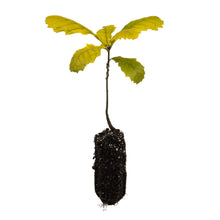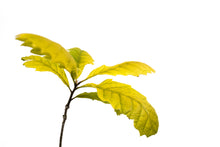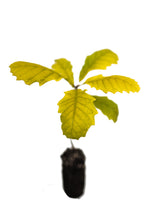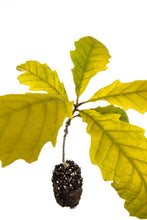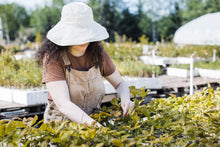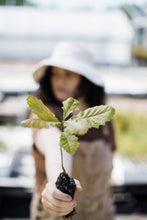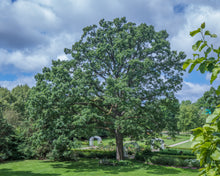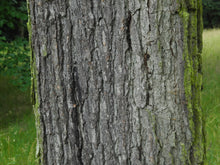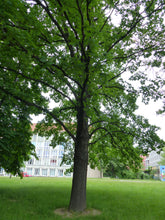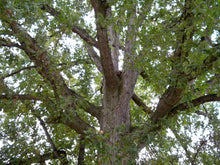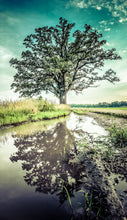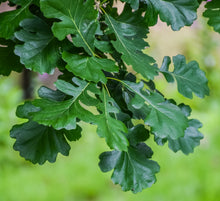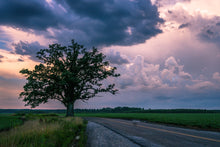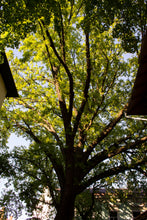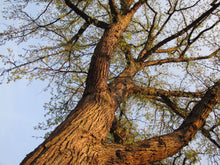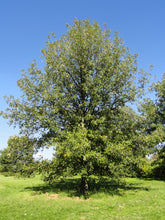
Quercus macrocarpa
-
Grow your own Bur Oak, producer of the largest acorns of any North American oak tree and an important source of food for wildlife!
- 100% guaranteed
- Seed-grown on California's Redwood Coast
- Transplanting and care instructions included
 |
Moisture Medium |
 |
Cold Hardiness -50°F |
 |
Light Full Sun |
 |
Size 70 – 100' tall / 50 – 100' spread |
 |
Lifespan 400 yrs |
 |
Growth Rate Slow Growing |
 |
Drought Tolerance High |
 |
Wind Resistance High |
About Bur Oak
From the U.S. Dept. of Agriculture:
"Bur oak typically grows as a large, spreading tree up to 130 feet (40 m) tall; however, growth form and size can vary by site. Branches in the upper portion of the crown are ascending; in the lower crown, branches are larger and horizontal. The trunks of mature trees have thick, deeply grooved bark and may measure 8.5 feet (2.6 m) in diameter. In the western part of its range on exposed, harsh sites, bur oak grows as a small tree or shrub and may produce crooked, gnarled branches. Bur oak growth forms may relate to moisture availability. In the Niobrara Valley Preserve, bur oak may only reach 15 feet (4.6 m) tall on moisture-limited sites but may reach 50 feet (15 m) tall on floodplains.
Bur oak is a long-lived tree. It is common to find remnant trees that are 300 to 400 years old, and in a savanna in Kentucky, a bur oak tree was an estimated 440 years old.
The sizes and shapes of bur oak leaves are variable, but generally leaves are deeply lobed and large, up to 12 inches (30 cm) long and about half as wide. Shallowly lobed leaves may occur on bur oak sprouts or deeply shaded branches, and small leaves are common in the Northern Great Plains. Leaves are deep green shiny above and coated with white hairs below. Bur oak produces male flowers in 3- to 4-inch (7-10 cm) long catkins, and female flowers are solitary or in clusters of up to 4.
Bur oak acorns are generally 1-seeded with a cup that covers at least 33% of the nut and may, though rarely, cover the entire nut. Acorn size and cup coverage can vary by site. In the Northern Great Plains, bur oak produces small fruits and cups with low coverage, which may be the result of past hybridization with Gambel oak. In general, acorn size decreases with increasing latitude; bur oak acorns from a site in Texas averaged 7.5 g, while in Minnesota they averaged 0.9 g. Diameter of acorns in Texas can be 2 inches (5 cm). Bur oak acorn size differences can even occur over small changes in latitude. Acorns produced in Wisconsin were much smaller than those produced in southern Illinois and Missouri. Acorn size can also vary with shadiness of habitat. In east-central Nebraska, bur oak acorns from shady habitats weighed more than those from open habitats. Acorns collected from a closed-canopy floodplain forest weighed 1.3 to 6 g and those from open savannas weighed 0.5 to 2.5 g."
About Jonsteen's Seedlings
About Jonsteen's 100% Guarantee
All of our trees are guaranteed to arrive healthy and in good condition. If your tree perishes despite your honest efforts, we will be happy to replace it with a small-sized seedling for just the cost of shipping/handling. You can learn more about our guarantee and tree replacement policy here.
Seedling Size Chart: Medium
Due to the dynamic nature of actively growing trees, as well as the tremendous variation between species’ growth rates, we rely on the cubic volume of a seedling’s root mass to determine its “size” (Small / Medium / Large / XL). Within each size there is minor variance — the dimensions provided here represent the category minimum. If exact measurements are essential, please contact us about current stock.





















